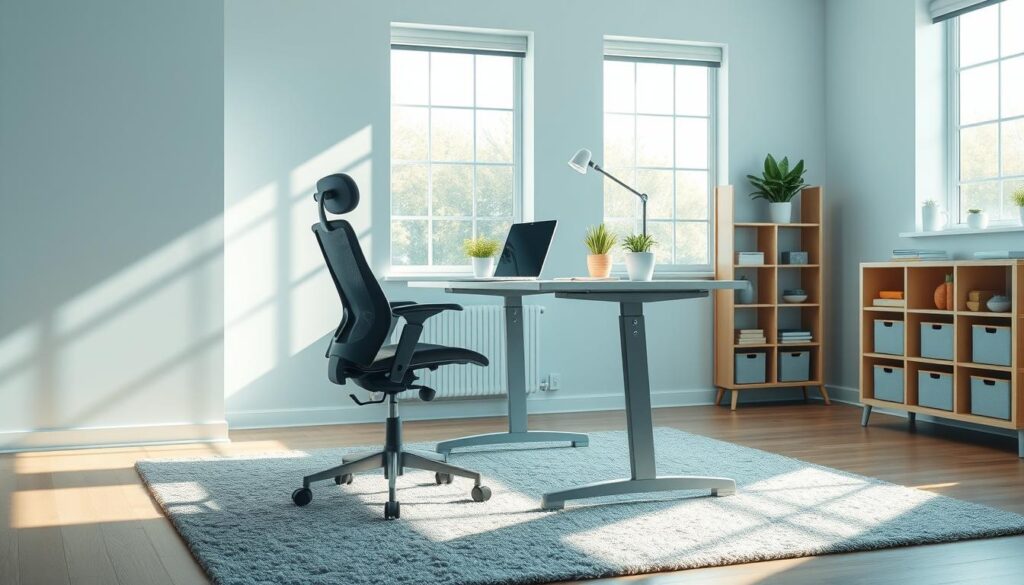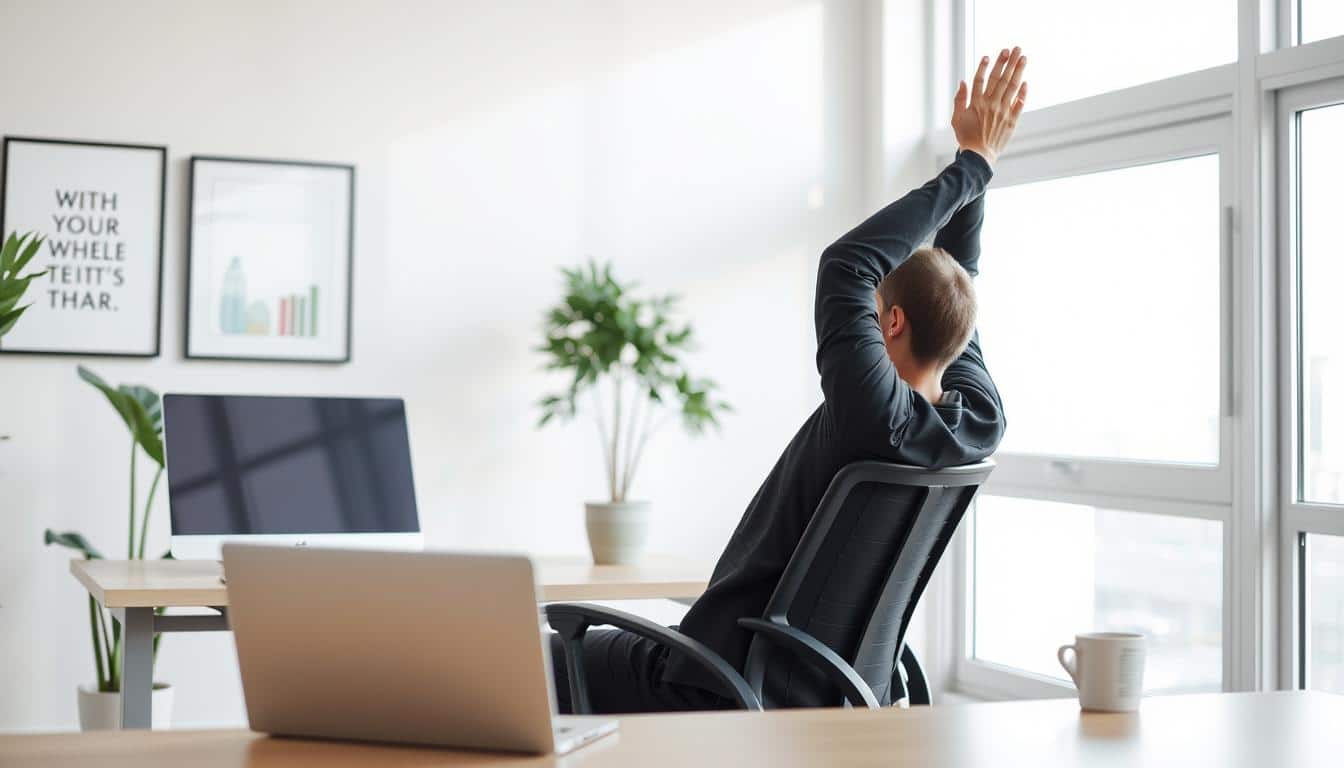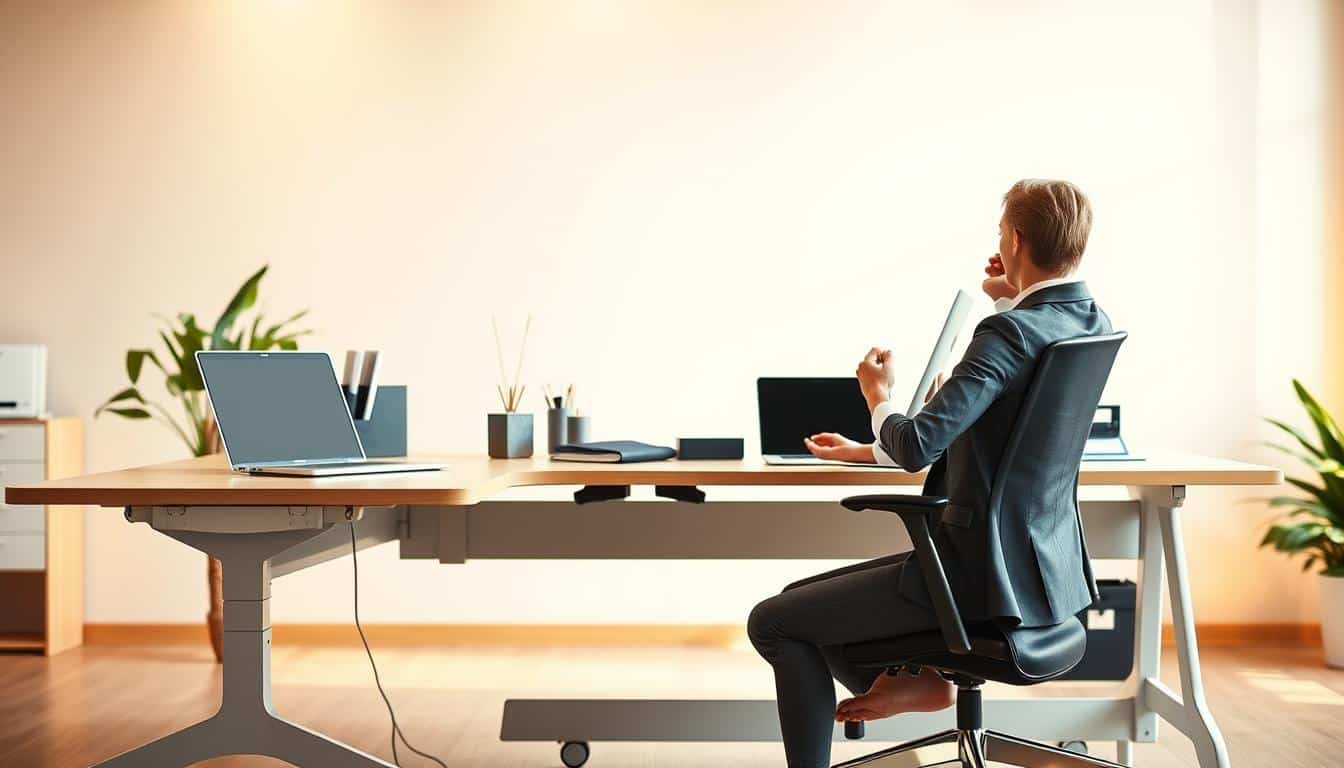Desk stretching exercises are getting more popular for office wellness. It’s key to add them to our daily schedule. Many people sitting for too long face health risks, but these easy exercises can help a lot.
You can do these stretches at your desk with no need for special tools. They take little time but can really refresh you. They help make you more flexible and keep you healthy at work all day.
The Importance of Office Wellness
Workplace wellness programs are now key in modern offices. They focus on keeping employees healthy through things like exercise, better work setups, and support for mental health. When workers take part in these wellness activities, they do more and feel better. This also saves money for companies on healthcare.
Understanding Workplace Wellness
Workplace wellness promotes health and activity at work. It supports better lifestyle choices, like regular stretching, encouraging employees to move more. This fights the downsides of sitting too long. A clear plan for regular stretching can improve both body and mind for office workers.
Impact of Sedentary Jobs on Health
Many jobs today mean sitting still for too long, which is bad for health. It leads to weight gain, body pain, and mental stress. Around 80% of workers in the U.S. mostly sit all day, increasing their chance of back and neck problems. Adding simple stretching to their day helps lessen these issues and makes the office a healthier place.
Common Issues from Sitting Too Long
Sitting for too long can lead to major health issues. These include musculoskeletal problems and added stress from work. By moving more and taking stretch breaks, we can improve our well-being.
Musculoskeletal Disorders
People with desk jobs often face musculoskeletal issues. Poor posture can cause neck and back pain, along with other injuries. Long hours of sitting put too much pressure on our spine.
Taking short breaks for movement and stretching helps. This promotes spinal health and lowers the chance of office-related pains.
Stress and Mental Fatigue
Sitting all day also affects our mental health. Work stress and physical pain can lead to mental fatigue, making us less productive. Studies show that moving around or stretching a bit during the day can help.
This reduces fatigue and makes our minds clearer. A more active day leads to a happier and more effective work life.
Benefits of Desk Stretching
Stretching at your desk can make you feel much better. It fights the bad effects of sitting too long. People who stretch at their desks often feel more flexible. They also focus better and hurt less.
Improved Flexibility and Range of Motion
Stretching regularly makes your muscles and joints more flexible. This helps you move better and prevents injuries. Doing stretches like leg raises and side stretches eases muscle tension. Because of this, you can sit and stand straighter and have less pain.
Increased Focus and Productivity
Stretching helps your blood circulate better, which sends more oxygen to your brain. So, workers get more done and can concentrate better all day. Stretch breaks during the day fight off physical and mental tiredness. This makes the team more lively and interested in their work.
Reduction of Pain and Discomfort
Stretching can really help reduce pain, with research showing a big drop in discomfort for those who stretch. These stretches ease muscle fatigue and tightness, especially in the back and hips. Adding stretches into the day lessens the chance of problems from not moving around much.
Simple Desk Stretching Techniques
Adding simple stretches to your workday can really boost your comfort and productivity. Simple moves like reaching overhead and twisting your torso not only ease muscle tightness but also better your well-being overall. Here are some great stretches to try out.
Overhead Reach Stretch
To do an overhead stretch, lift your arms high and weave your fingers together. Push your palms up and out gently. This action helps make your spine longer and adds flexibility to your upper body. Stay in this stretch for 10 to 30 seconds to ease stiffness.
Torso Stretch Variations
Torso stretches are great for making your spine more flexible. For a simple twist, sit and put one hand behind you on the chair. Then, gently turn your body the other way. To do a forward stretch, lean forward in your seat and let your arms hang down to the floor. These exercises are quick and you don’t have to leave your desk to do them.
Stretching for Neck and Shoulders
Stretching your neck and shoulders is key if you sit a lot for work. These exercises relieve neck pain and make you feel better at your job. Adding shoulder stretches fights the bad effects of sitting too much. Try these stretches to feel better and work better throughout your day.
Neck Stretches
Neck stretches help ease the tension from staring at screens all day. Here are some easy exercises for daily use:
- Neck Tilt: Tilt your head to each side and hold for 10-20 seconds. Repeat 2-3 times on each side.
- Chin to Shoulder Stretch: Turn your chin towards your shoulder, holding for 10-20 seconds. Repeat twice on each side.
- Forward Head Tilt: Gently tilt your head forward, holding for 5-10 seconds. Repeat 3-5 times.
Shoulder Shrugs and Rotations
Shoulder shrugs and rotations beat stiffness and improve how your shoulders move. Add these stretches to your workday routine:
- Shrug the Shoulders: Raise your shoulders up to your ears, hold for 3-5 seconds, then relax. Do this 2-3 times.
- Shoulder Blade Stretch: With fingers locked behind your head, pull your shoulder blades together and hold for 8-10 seconds. Repeat a few times.
- Arm Across Chest Stretch: Hold your elbow with the opposite hand and pull it across your chest. Keep it there for 15-20 seconds per side.
Leg and Knee Stretches at Your Desk
Adding leg stretches and knee exercises to your desk routine improves comfort and work productivity. These exercises are easy to do at your desk using very little space. They help make your legs and knees more flexible, strong, and improve blood flow.
Hamstring and Calf Stretches
To stretch your legs at your desk, try hamstring and calf stretches. For the hamstrings, straighten one leg out and reach towards your toes. This makes the hamstrings more flexible. For the calves, try lifting your heels off the floor while sitting to work these muscles and help your knees. You can also add weights or do these exercises standing for more challenge.
Knee Flexion Exercises
Knee movements are essential for keeping them moving smoothly and avoiding stiffness. Bending and straightening your knees while seated helps blood flow and joint health. You can also do seated marching to work your hips and thigh muscles. Lifting your knees one at a time strengthens important muscle areas. Try doing knee circles too, by lifting a foot and rotating your toes in circles, to keep your knee joints flexible.
Incorporating Desk Stretching into Your Routine
Adding stretching to your daily work routine brings many health benefits. A structured approach helps you consistently stretch, improving posture and reducing tension. Having set times for stretching can boost your overall health.
Creating a Stretch Schedule
To add stretching into your day, make a regular schedule. Use timers to remind you every hour, helping you focus on well-being. Include stretches for different areas, like:
- Shoulder and neck stretches to alleviate tension.
- Arm and wrist stretches for improved flexibility.
- Hip and glute stretches for better mobility.
These actions help with blood flow, ease muscle stiffness, and raise energy during the day.
Using Apps for Reminders
Apps like StretchClock play a key part in encouraging movement at work. They send you hourly reminders to stretch, making sure your health isn’t forgotten. Responding to these reminders, you’ll notice better focus and less discomfort, leading to a happier, more efficient workday.
Desk Stretching for Office Teams
Adding desk stretching to work routines can really help team well-being. Doing stretches together helps team members work better together and build stronger bonds. This group activity not only lifts spirits but also highlights the importance of keeping fit with regular exercise.
Group Stretching Sessions
Setting up group stretching sessions can make for a fun team activity. By picking a time for everyone to stretch together, it makes sure everyone takes part. Here are some good stretches you can do at your desk:
- Seated chest opener
- Seated chin tuck
- Seated thoracic rotation
- Standing chest opener
- Child’s pose on the wall
- Banded pull-aparts
- Kneeling hip flexor stretch
- Hamstring stretch
These stretches can make you more flexible and reduce aches from sitting too long. Doing them as a team can help improve focus and work better together.
Creating a Wellness Culture at Work
Building a workplace that values stretching breaks and talks openly about wellness is key. Companies should encourage taking stretch breaks to improve not just health but also the mood around the office. Training on flexibility can decrease the chance of muscle and joint issues, make employees happier, and keep them around longer.
Additional Tips for Office Wellness
Making your office a better place to work is key for health and energy. Setting up an ergonomic workspace helps maintain good posture and lowers health risks from sitting too long. It’s also good to move around during the day to keep the office lively and productive.
Ergonomic Workspace Setup
Having a comfortable place to work is vital. Adjustable desks and chairs help avoid discomfort. To make your office space better for your health, try these tips:
- Adjust chair height to keep feet flat on the floor.
- Position your monitor at eye level to avoid neck strain.
- Ensure keyboard placement allows for your wrists to remain straight.
Integration of Movement During the Workday
Adding movement into your day is not just good for avoiding the downsides of sitting too much. It also makes you more productive. Small changes can lead to big health benefits. Here’s what you can do:
- Stand during phone calls to promote circulation.
- Use walking meetings to combine discussion with light exercise.
- Incorporate short breaks for stretches or brief walks.
These steps help ease muscle tightness and increase flexibility. They make for a healthier place to work.

Conclusion
Adding stretching exercises at your desk to your day can make you healthier and more productive. It’s important to know how these stretches fight the downsides of sitting too much. With simple moves like stretching your neck, rolling your shoulders, and twisting your trunk, you can shake off discomfort and build good work habits.
Remember to stretch every 30 minutes and take short walks to break up sitting time. These habits boost flexibility, blood flow, and good posture while cutting down stress. This makes your work area a nicer place to be. Keeping up with these stretches regularly makes their benefits even bigger.
Desk stretching and office well-being go hand in hand when we make an effort to take care of ourselves. By making these small changes important, employees can change their work life for the better. This leads to sharper focus, less stress, and a healthier way of working.



